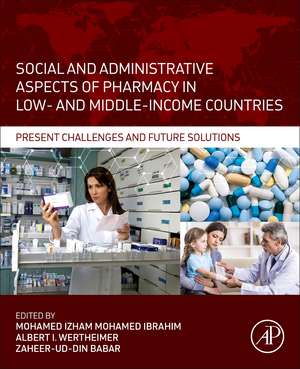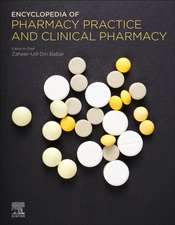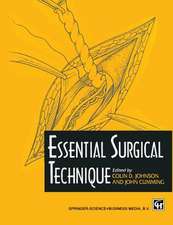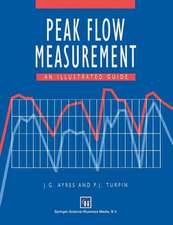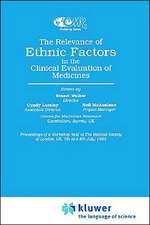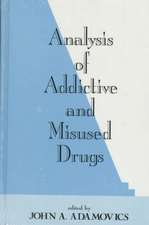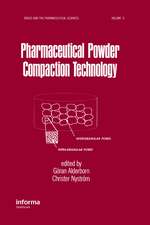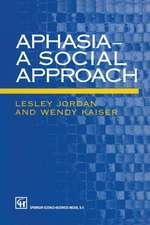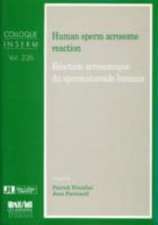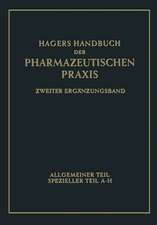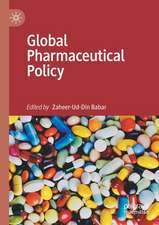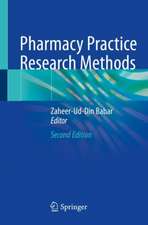Social and Administrative Aspects of Pharmacy in Low- and Middle-Income Countries: Present Challenges and Future Solutions
Editat de Mohamed Izham Mohamed Ibrahim, Albert Wertheimer, Zaheer-Ud-Din Babaren Limba Engleză Paperback – 24 oct 2017
While some practices may be applied appropriately in disparate places, too often pharmacy practice in low- and middle-income countries is directly copied from successes in developed countries, despite the unique needs and challenges low- and middle-income countries face.
- Examines key issues and challenges of pharmacy practice and the pharmaceutical sector specific to low- and middle-income countries
- Compares pharmacy practice in developed and developing countries to highlight the unique challenges and opportunities of each
- Provides a blueprint for the future of pharmacy in low- and middle-income countries, including patient-centered care, evidence-based care and promoting the role of the pharmacist for primary health care in these settings
Preț: 492.20 lei
Preț vechi: 610.35 lei
-19% Nou
Puncte Express: 738
Preț estimativ în valută:
94.19€ • 102.28$ • 79.12£
94.19€ • 102.28$ • 79.12£
Carte tipărită la comandă
Livrare economică 15-29 aprilie
Preluare comenzi: 021 569.72.76
Specificații
ISBN-13: 9780128112281
ISBN-10: 012811228X
Pagini: 484
Dimensiuni: 191 x 235 x 27 mm
Editura: ELSEVIER SCIENCE
ISBN-10: 012811228X
Pagini: 484
Dimensiuni: 191 x 235 x 27 mm
Editura: ELSEVIER SCIENCE
Public țintă
Practicing pharmacists, pharmacy leaders in academic and practice sites, pharmacy educators, health services researchers, researchers in social and administrative pharmacy, researchers in pharmacy practice and education, pharmacy graduate students, consultants, international pharmaceutical companies, public health policy makers, international medicine use organizations, international organizations concerned with health (e.g. WHO, United Nations, etc.)Cuprins
1. Introduction: Discovering Issues and Challenges in Low- and Middle-Income Countries
Section I: Socio-behavioral Aspects of Medicines Used in Low- and Middle-Income Countries
2. Socio-Behavioral Aspects of Medicine Used in Low- and Middle-Income Countries
3. Patients’, Consumers’ and Healthcare Professionals’ Perceptions, Beliefs, Knowledge, Attitudes and Practices Towards the Use of Medicines
4. The Use of Measurements and Health Behavioral Models to Improve Medication Adherence
Section II: Pharmaceutical Promotion in Low- and Middle-Income Countries
5. Academic Detailing in Low- and Middle-Income Countries: Principles, Use, Impact and Lessons Learned
Section III: Economic Evaluation and Medicine Expenditure in Low- and Middle-Income Countries
6. Economic Evaluation and Medicine Expenditure in Low- and Middle-Income Countries
7. Medicine Pricing Policy and Strategies in Low- and Middle-Income Countries: A Review
8. Economic Evaluation of Predominant Disease in Low- and Middle-Income Countries: Diabetes Mellitus
Section IV: Pharmacovigilance and Patient Safety in Low- and Middle-Income Countries
9. Pharmacovigilance Practices and Activities: Issues, Challenges, and Future Direction
10. Behavioral Aspects of Pharmacovigilance: Research Methods Considerations
11. Knowledge, Attitude, and Practice of Pharmacovigilance in Low- and Middle-Income Countries
Section V: Generic Medicines Used in Low- and Middle-Income Countries
12. Overcoming Challenges of Generic Medicine Utilization in Low- and Middle-Income Countries: Lessons Learned from International Experiences
13. Assessment of Policies, Determinants and Characteristics of Generic Medicine Entry into the Pharmaceutical Markets
Section VI: Rational and Responsible Medicine Use in Low- and Middle-Income Countries
14. Misconceptions and Misues of Drugs by Prescribers, Dispensers and Consumers
15. Strengths and Weaknesses of Pharmaceutical Policy in Relation to Rational and Responsible Medicines Use
16. Rational and Responsible Medicines Use
Section VII: Quality of Public Health Pharmacy Services in Low- and Middle-Income Countries
17. Quality of Pharmacy Health Services
18. Assessment of Medicine Dispensing and Extended Community Pharmacy Services
19. Enhancing Quality of Patient-Centered Care Services in Low- and Middle-Income Countries: Pharmaceutical Care Approach
20. Politics and Competition between Professions: Future Scope of Pharmacy Practice
Section VIII: Medicine Quality: Substandard and Counterfeit Medicine in Low- and Middle-Income Countries
21. Perspective, Knowledge, Attitude, and Belief of Various Stakeholders on Medicines Quality: Counterfeit and Substandard Medicines
Section IX: Medicine Information and Health Literacy in Low- and Middle-Income Countries
22. Issues on Source, Access, Extent and Quality of Information Available Among Pharmacists and Pharmacy Personnel to Practice Effectively
Section X: Good Governance and Pharmaceutical Policy in Low- and Middle-Income Countries
23. Problems and Obstacles of Low- and Middle-Income Countries in Having Good Governance and Quality and Effective Pharmaceutical Policy
24. Pharmacogovernance: Advancing Pharmacovigilance and Patient Safety
25. Pharmaceutical Policy: Synthesis, Themes and Future Directions
Section I: Socio-behavioral Aspects of Medicines Used in Low- and Middle-Income Countries
2. Socio-Behavioral Aspects of Medicine Used in Low- and Middle-Income Countries
3. Patients’, Consumers’ and Healthcare Professionals’ Perceptions, Beliefs, Knowledge, Attitudes and Practices Towards the Use of Medicines
4. The Use of Measurements and Health Behavioral Models to Improve Medication Adherence
Section II: Pharmaceutical Promotion in Low- and Middle-Income Countries
5. Academic Detailing in Low- and Middle-Income Countries: Principles, Use, Impact and Lessons Learned
Section III: Economic Evaluation and Medicine Expenditure in Low- and Middle-Income Countries
6. Economic Evaluation and Medicine Expenditure in Low- and Middle-Income Countries
7. Medicine Pricing Policy and Strategies in Low- and Middle-Income Countries: A Review
8. Economic Evaluation of Predominant Disease in Low- and Middle-Income Countries: Diabetes Mellitus
Section IV: Pharmacovigilance and Patient Safety in Low- and Middle-Income Countries
9. Pharmacovigilance Practices and Activities: Issues, Challenges, and Future Direction
10. Behavioral Aspects of Pharmacovigilance: Research Methods Considerations
11. Knowledge, Attitude, and Practice of Pharmacovigilance in Low- and Middle-Income Countries
Section V: Generic Medicines Used in Low- and Middle-Income Countries
12. Overcoming Challenges of Generic Medicine Utilization in Low- and Middle-Income Countries: Lessons Learned from International Experiences
13. Assessment of Policies, Determinants and Characteristics of Generic Medicine Entry into the Pharmaceutical Markets
Section VI: Rational and Responsible Medicine Use in Low- and Middle-Income Countries
14. Misconceptions and Misues of Drugs by Prescribers, Dispensers and Consumers
15. Strengths and Weaknesses of Pharmaceutical Policy in Relation to Rational and Responsible Medicines Use
16. Rational and Responsible Medicines Use
Section VII: Quality of Public Health Pharmacy Services in Low- and Middle-Income Countries
17. Quality of Pharmacy Health Services
18. Assessment of Medicine Dispensing and Extended Community Pharmacy Services
19. Enhancing Quality of Patient-Centered Care Services in Low- and Middle-Income Countries: Pharmaceutical Care Approach
20. Politics and Competition between Professions: Future Scope of Pharmacy Practice
Section VIII: Medicine Quality: Substandard and Counterfeit Medicine in Low- and Middle-Income Countries
21. Perspective, Knowledge, Attitude, and Belief of Various Stakeholders on Medicines Quality: Counterfeit and Substandard Medicines
Section IX: Medicine Information and Health Literacy in Low- and Middle-Income Countries
22. Issues on Source, Access, Extent and Quality of Information Available Among Pharmacists and Pharmacy Personnel to Practice Effectively
Section X: Good Governance and Pharmaceutical Policy in Low- and Middle-Income Countries
23. Problems and Obstacles of Low- and Middle-Income Countries in Having Good Governance and Quality and Effective Pharmaceutical Policy
24. Pharmacogovernance: Advancing Pharmacovigilance and Patient Safety
25. Pharmaceutical Policy: Synthesis, Themes and Future Directions
